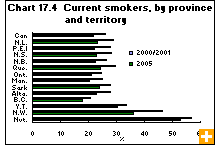Common menu bar links
Less exposure to second-hand smoke
Archived Content
Information identified as archived is provided for reference, research or recordkeeping purposes. It is not subject to the Government of Canada Web Standards and has not been altered or updated since it was archived. Please contact us to request a format other than those available.
Widespread smoking bans in public places appear to have reduced the proportion of smokers in Canada. An estimated 22% of Canadians smoked in 2005, down from 26% in 2000/2001. The sharpest decline is among youth aged 12 to 17 years—a growing proportion of young Canadians have never smoked.
As smoking bans in public places have become more common, exposure to second-hand smoke among non-smokers has also declined. The restrictions may have helped to change the behaviour of smokers in other places, such as homes and cars.
In 2005, 23% of non-smokers reported regular exposure to second-hand smoke in at least one of the following types of locations: public places, homes and private vehicles. This proportion is down from 29% two years earlier.
Even so, the most common location for exposure to second-hand smoke is public places. In 2005, 15% of non-smokers reported that public places are the location where they are most often exposed to second-hand smoke. The proportion of non-smokers exposed to second-hand smoke at home is 9%, and in private vehicles, 8%.
The risk of exposure to second-hand smoke in at least one type of location is highest among young people. In 2005, about 40% of non-smokers aged 12 to 17 reported regular exposure to second-hand smoke in at least one type of location. By comparison, the rate is 31% for those aged 18 to 34, 19% for those aged 35 to 64, and 11% for those 65 and older.



